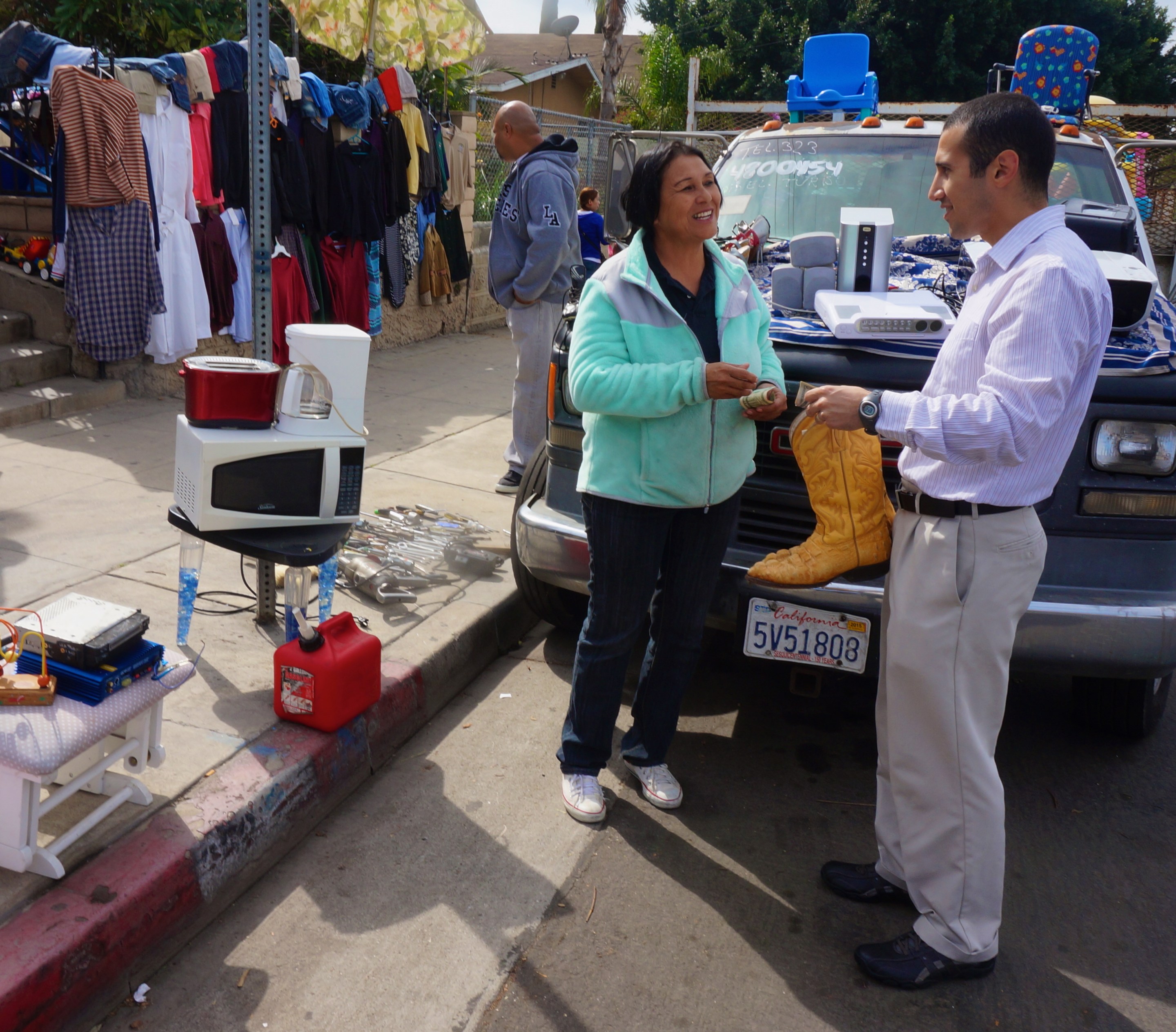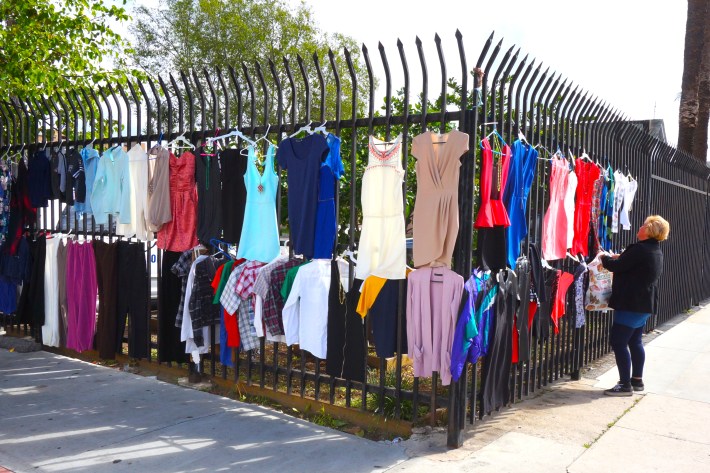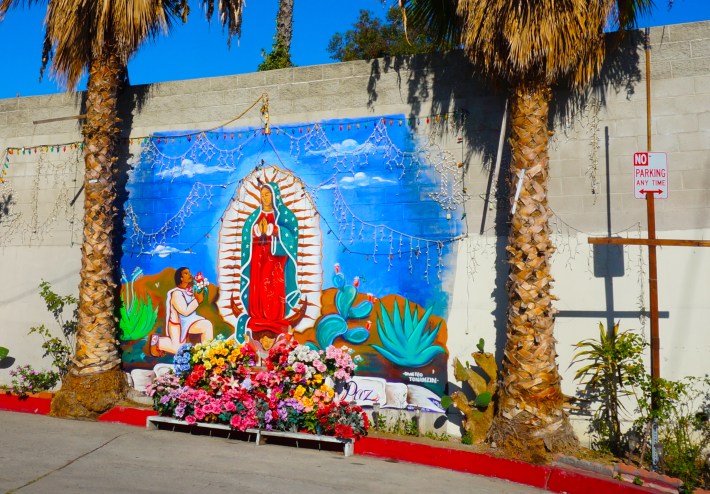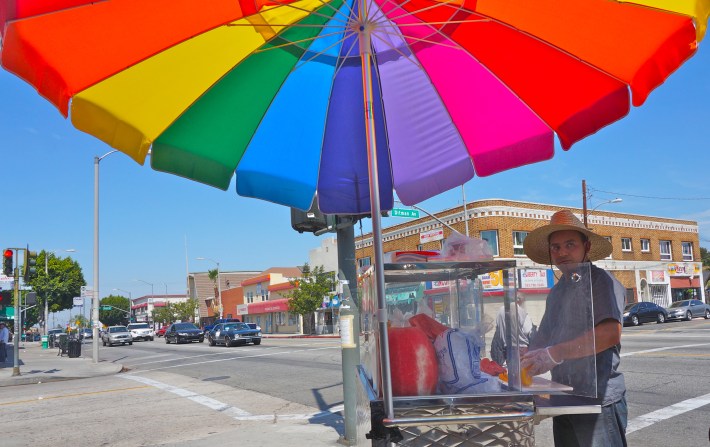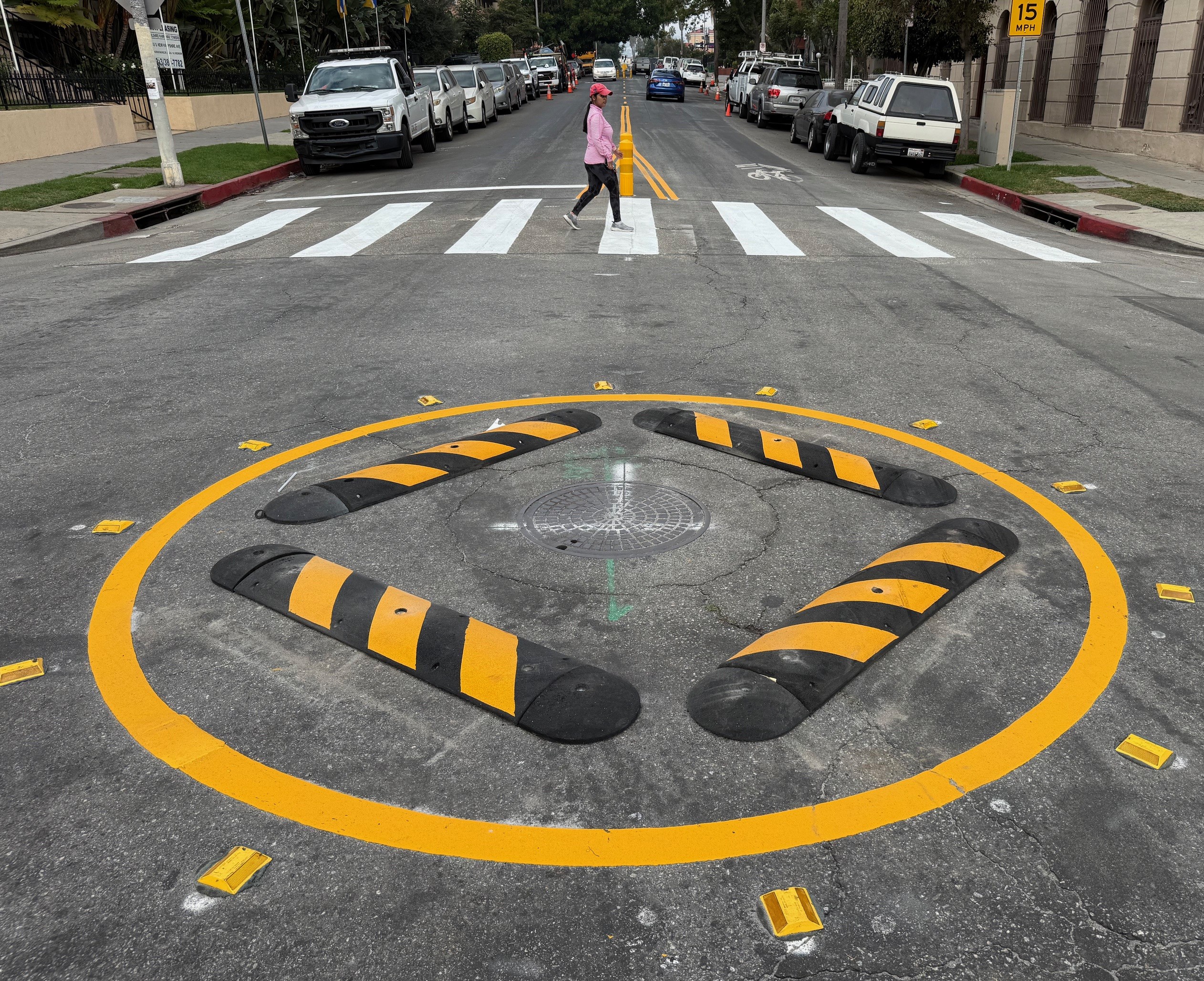Latinos add their mobility patterns to U.S. auto-designed streets to create an innovative pedestrian vernacular streetscape. This vernacular offers cultural, economic, and social solutions and opportunities for Latino mobility needs as they customize and personalize their neighborhood streets.
Every change Latinos make to their streets, no matter how small, has meaning and purpose, representing the struggles, triumphs, everyday mobility habits, and beliefs of new U.S. pedestrians. Many fancy-pants urban designers poo-poo the Latino pedestrian vernacular because it’s messy, informal, and spontaneous or it’s only for poor immigrants to cope until they join the middle class. These solutions, and the grassroots approach that generates them, represent a resource that the nation's non-Latinos should draw on in transitioning to a more sustainable and less auto-dominated country.
As great numbers of Latino immigrants settle into U.S. suburbs, they bring attitudes towards walking that often differ from those of many longtime Angelenos.
Latino pedestrian vernacular synthesizes cultural styles and scales that are neither “Spanish” (as the general public views it) nor Anglo American. The beauty of the vernacular cannot be measured by any urban design or architectural standard but rather by life’s experiences, expressions, and adaptations. The vernacular represents Latinos’ adaptation to their environment.
Very few signs or landmarks will indicate Latino neighborhoods. However, one will know when one has arrived there because of the large number of people on the streets as compared to the scarcity of people on the streets of other parts of cities. Street life is an integral part of the community fabric because it brings people together. Streets serve as plazas by creating a real sense of place in Latino neighborhoods.
Many Latinos come from the urban and rural places of Mexico or Latin America where social, cultural, climate— and to some extent economic — life centers on walking to and around the zocalo or plaza. The plaza becomes an extension of residents’ home life. The dialogue between home and plaza —which is very apparent in the physical structures of Latin American settlements — manifests itself in the way Latinos redesign their suburban streets.
After work or dinner most Angelenos will settle into their couches to watch TV; for Latinos this is a time for walking. This social practice is similar to the Italian “passeggiata” or evening stroll of residents after work. However unlike the great Italian streets and ‘piazzas” which have been designed for strolling, Latinos are forced to retrofit the suburban street for walking. Instead of admiring great architecture or sculptures, Latinos are socializing over fences and gates.
Residential Streets
Nowhere else in the Latino vernacular home is Mexican use of space so illuminated and celebrated as in the enclosed front yard or plaza. The personalization of la yarda by the residents, along with the enclosing fences, has greatly changed the appearance of the front yards and the street. The Latino household extends its presence to all four corners of the building lot. In Latino neighborhoods, enclosed front yards are now so dominant that they have altered neighborhoods' general physical characteristics and residents’ behavior patterns. The continuous green, park-like setting that symbolized the American suburban front yard has been cut into individual slices in East Los Angeles. These “slices” readily allow for individuality and sociability and create diversity. The front yard plaza promotes walking by creating a street wall that scales the environment down from the automobile to the pedestrian.
The visible expanse of lawn fronting American suburban houses is a symbol of ownership and privacy. It is also a psychological barrier that separates the private space of the home from the public space of the street. People do not walk on another person’s front lawn unless they are invited to.
In Latino neighborhoods, by contrast, fences bring neighbors and pedestrians together. The Latino front-yard fence creates an edge where people tend to congregate — a comfortable point for social interaction between resident and pedestrian.
Residents communicate with each other via the front yard. Building fences binds together adjacent homes. By adding and enlarging front porches, Latino residents extend the household into the front yard. These physical changes allow and reinforce social connections and heavy use of the front yard. The entire street now functions as a “suburban” plaza where every resident can interact with the public from his or her front yard. Thus Latinos have transformed car-oriented suburban blocks to walkable and socially sustainable places.
Commercial Streets
Using small, everyday household objects in the public realm adds a second layer of architecture to the Latino pedestrian vernacular. These objects help Latinos create an intimate venue in urban space. From clothes being hung on a fence for sale to household objects simply placed on a sidewalk, these items scale down the urban landscape to a pedestrian level. Movable objects allow Latinos to use outdoor space in spontaneous ways. These objects give Latinos flexibility and freedom over their environment.
Very few walls are left untouched in Latino streetscapes. From graffiti to store signs to murals, wall space becomes a cultural expression for the residents. The use of paint helps Latinos to inexpensively claim ownership of space or express themselves. The use of graphics adds a strong visual element to the urban form. Buildings are kinetic because of the flamboyant words and graphics used. Many building areas are covered from top to bottom with graphics. Murals can be political, religious or used for business advertisement. Many neighborhood murals are both political and religious in nature. One of the unique urban advantages about murals is that they liven up a space. Nowhere is this more apparent than the side streets from commercial streets where shop keepers have murals painted to advertise and to keep graffiti from being noticed.
Many murals are painted on the large expansive blank walls on the side of the buildings that face residential streets. An interesting urban dynamic takes place because the commercial activity is wrapped around the building onto the residential side streets meshing both land uses and providing both residents and vendors space to congregate. These simple graphics also create a pedestrian-friendly environment by adding color to the walk.
Virgin de Guadalupe shrines are one of the most recognizable landmarks in Latino streetscapes. These shrines appear everywhere from front yards, murals, store signs, to parking lots. The installation of lavish Nativity scenes on Latino front yards is also very popular. These shrines highlight how religion plays an important part in the daily lives of Latinos and how Latinos can transform underutilized space to sacred space, adding complexity to the experience of walking.
Most of L.A.’s pedestrian-oriented streets and districts are predicated on the transportation pattern of people driving there, parking, and then walking. Examples of drive-there-to-walk-there districts include Old Town Pasadena, Sunset Junction, Third Street Promenade, and Olvera Street. By and large these areas are regional pedestrian draws containing particularly expensive commercial space. Thus the retail and commerce in these districts tends to consist of national or regional chains. Parking is extensive and is most often housed in massive parking structures scattered throughout the district.
In the case of pedestrian-oriented streets and districts in Latino communities, the opposite most often happens. The businesses tend to be small and local, and a large part of their clientele consists of everyday residents coming on foot from the adjacent residential neighborhoods. Parking tends to be minimal to non-existent, and the merchandise shop owners stock tends to be small or in small quantities (e.g., a four-pack of toilet paper as opposed to a 36-pack) so that people can carry these items home. As a result of these very locally-tinged factors, a non-resident has very little reason to visit these Latino commercial streets.
Another difference between Latino and more conventional pedestrian districts lies in the physical design of the two environments. Pedestrian-oriented Latino commercial streets tend to be rather do-it-yourself (DIY) in their look and feel. Trees have often been planted by residents or business owners themselves. Signs are hand-painted or hand-crafted and exude individuality rather than consistency. Merchandise is frequently placed out on the sidewalk to entice buyers in. Building setbacks are inconsistent. Some storefronts are simply built-out extensions of people's homes. The result is an environment that is tactile, full of a particular visual and sensual energy, and that contains a sort of hodgepodge messiness not often found in the more regional pedestrian-oriented districts of L.A. Somewhat ironically, it is this vibrancy that the more regional pedestrian districts try so hard to create via a top-down control of scale, uses, consistent tree canopy, wide sidewalks, fountains, and public art.
Streets serve a vital economic function in Latino communities by doubling as space for selling goods and/or labor in the form of street vending. In L.A. there are an estimated ten- to eighteen-thousand street vendors operating illegally in the city's streets. Through street vending, Latinos have ingeniously retrofitted auto-oriented streets and spaces to fit their economic needs. The result is a daily but temporary transformation of vacant lots, old gas stations, sidewalks, and curbs into small hubs of commerce and economic activity. These are spaces that would otherwise remain moribund in the absence of this kind of enterprising and mobile economic activity.
Transportation
Walking is a primary means of transportation in Latino neighborhoods. Many Latinos walk to stores, schools, homes of family and friends, and to use public transportation.
Pedestrian safety is a critical issue in Latino neighborhoods. Latinos ‘throw a wrench’ in the design and planning of the city by walking, using public transit, and using streets and sidewalks for purposes other than just exiting and entering one's automobile. The city's transportation agencies focuses on improving automobile mobility by adding car capacity (supposedly to reduce congestion) and increasing vehicle speeds. These are done at the expense of pedestrian safety. Hardest hit by these "congestion relief" mitigations are primarily Latinos. Many of Los Angeles' Latino residents live in older, inexpensive multi-family housing on wide busy streets with high traffic volumes and nearby freeways that increase air pollution.
Although L.A. could benefit from the creative bottom-up changes of Latino residents, there are times when the city's policies and procedures work in a way that is actually counter productive. One particular example of this is the bus stop.
In Los Angeles, Latinos account for the majority of transit riders. Bus stops have thus become important community and economic nodes in transit-dependent Latino neighborhoods. Street vendors gather at bus stops to sell their wares to attendant riders. While encouraging this kind of economic activity could ultimately draw in more people and boost ridership, L.A. and the regional transit authority have most often ignored this potential at best, or, at worst, discouraged it. As a result, these mini-hubs of commerce and transportation sorely lack fundamental features such as shade, seating, and adequate space for both vendors and those waiting for the bus.
To be fair, the lack of bus stop features is in part due to the limited jurisdiction of the transit agency over the actual design of each bus stop. Typically transit agencies are only responsible for the location of the bus stop and the placement of the post and sign displaying line number and sometimes arrival and departure times. The local municipality, on the other hand, has jurisdiction over the land where the bus stops are located. Unfortunately municipalities are not in the transit business and generally do not have policies that encourage transit ridership. There are exceptional occasions when the municipality serves as the transit operator, which actually can create a comprehensive approach to bus stop improvements. However, most cities rarely have the funds to allocate to the construction and maintenance of bus stop features. Therefore many municipalities contract out the construction, installation and maintenance of bus shelters to private advertising companies. A few large advertising companies have taken over bus shelter contracts for major cities. These companies sell advertising space that pays for the installation and upkeep of the bus shelters and give the city a percentage of the profits. Often times, however, these spruced-up bus shelters are located in higher-income, higher-traffic areas and not at stops with the highest rates of boarding and thus with the most need for the features in the first place.
Conclusion
The prevailing view and attitude in L.A. has been that streets are simply for cars. Streets in Latin America, on the other hand, often have pedestrian-supporting features woven into them. Frequently vehicles must share space with mobile and temporary activities from pop-up markets to food vendors to social interactions. The notion that streets are simply space for cars is foreign to many immigrants coming to Los Angeles from Latin America. These Latino immigrants are creating a new pedestrian design lexicon. Latinos are reshaping suburban streets by walking and creating a sense of place in what was a place-less environment.
While the phenomenon of people bringing a completely different set of attitudes toward the street can sometimes create serious conflicts between pedestrians and vehicles, it also presents a wealth of opportunities that the city of Los Angeles can learn to take advantage of as it moves beyond an auto-only approach to transportation.
For the past 25 years, James Rojas have been observing, researching, and documenting the ways in which Latinos are transforming land use and transportation infrastructure to fit their needs. He has become one of the few nationally recognized experts on this topic and has written and lectured extensively on how culture and immigration can transform communities. He is the founder of the Latino Urban Forum, an advocacy group dedicated to increasing awareness of planning and design issues facing low-income Latinos. Rojas has lectured and facilitated workshops at MIT, Berkeley, Harvard, Cornell, and numerous universities, schools and public forums. His research has appeared in the New York Times, Los Angeles Times, Dwell, Places, and in numerous books. He developed a keen eye for and a critical perspective of the US-Latino built environment.
